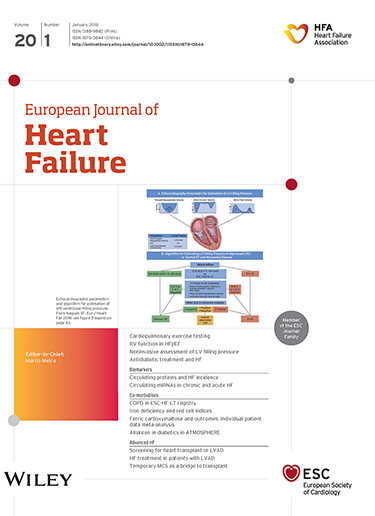静脉注射羧麦芽糖铁治疗缺铁性心力衰竭(FAIR‐HF2 DZHK05试验):性别特异性结局
IF 10.8
1区 医学
Q1 CARDIAC & CARDIOVASCULAR SYSTEMS
引用次数: 0
摘要
目的静脉补铁已成为心力衰竭和缺铁患者的一种指南推荐治疗方法,但其疗效的潜在性别差异尚不清楚。我们的目的是评估收缩期心力衰竭和缺铁患者静脉铁治疗的性别特异性结局,以改善发病率。死亡率(FAIR‐HF2‐DZHK05)试验。方法和结果fair‐HF2纳入1105例左心室射血分数≤45%且缺铁的心力衰竭患者。共有368名女性(平均年龄68.7±13.0岁)和737名男性(平均年龄70.5±11.0岁)被随机分为静脉注射羧麦芽糖铁组和安慰剂组。三个主要终点是(i)至心血管死亡或首次心力衰竭住院的时间,(ii)总心力衰竭住院时间,以及(iii)仅在基线时转铁蛋白饱和度为20%的患者中,至心血管死亡或心力衰竭住院的时间。风险比(人力资源)第一主要结果为1.07(95%可信区间(CI) 0.63 - -1.82, p = 0.80)在妇女和0.74 (95% CI 0.57 - -0.95, p = 0.016),男性,而速度比率(RRs)第二个主要结果分别为1.06 (95% CI 0.55 - -2.05, p = 0.86)和0.79 (95% CI 0.58 - -1.08, p = 0.136),分别和第三个小时主要结果事件是1.21 (95% CI 0.62 - -2.36, p = 0.58)和0.73 (95% CI 0.55 - -0.97, p = 0.028),分别。关于安全性结果,女性全因死亡率的HR为1.46 (95% CI 0.78-2.76, p = 0.24),表明补充铁会增加死亡风险,而男性的HR为0.86 (95% CI 0.64-1.16, p = 0.33)(相互作用p = 0.13)。结论静脉注射铁治疗心力衰竭的疗效在两性中存在差异。虽然接受羧基麦芽糖铁治疗的男性在心血管死亡和心力衰竭住院方面有临床相关的减少,但女性没有获得类似的益处。该结果具有临床相关性,并可在其他大型结果试验中迅速验证静脉补铁治疗心力衰竭。临床试验注册:ClinicalTrials.gov NCT03036462。本文章由计算机程序翻译,如有差异,请以英文原文为准。
Intravenous ferric carboxymaltose in heart failure with iron deficiency (FAIR‐HF2 DZHK05 trial): Sex‐specific outcomes
AimsIntravenous iron has emerged as a guideline‐recommended therapy in patients with heart failure and iron deficiency, but the potential sex‐related differences in efficacy are unknown. We aimed to assess sex‐specific outcomes in the Intravenous Iron in Patients with Systolic Heart Failure and Iron Deficiency to Improve Morbidity & Mortality (FAIR‐HF2‐DZHK05) trial.Methods and resultsFAIR‐HF2 included 1105 heart failure patients with a left ventricular ejection fraction ≤45% and iron deficiency. A total of 368 women (mean age 68.7 ± 13.0 years) and 737 men (mean age 70.5 ± 11.0 years) were randomized to intravenous ferric carboxymaltose or placebo. The three primary endpoints were (i) time to cardiovascular death or first heart failure hospitalization, (ii) total heart failure hospitalizations, and (iii) time‐to‐first event of cardiovascular death or heart failure hospitalization only in patients with transferrin saturation <20% at baseline. The hazard ratio (HR) for the first primary outcome was 1.07 (95% confidence interval [CI] 0.63–1.82, p = 0.80) in women and 0.74 (95% CI 0.57–0.95, p = 0.016) in men, while the rate ratios (RRs) for the second primary outcome were 1.06 (95% CI 0.55–2.05, p = 0.86) and 0.79 (95% CI 0.58–1.08, p = 0.136), respectively, and the HRs for the third primary outcome event were 1.21 (95% CI 0.62–2.36, p = 0.58) and 0.73 (95% CI 0.55–0.97, p = 0.028), respectively. Regarding safety outcomes, the HR for all‐cause mortality was 1.46 (95% CI 0.78–2.76, p = 0.24) in women, suggesting increased mortality risk under iron supplementation, in contrast to 0.86 (95% CI 0.64–1.16, p = 0.33) in men (p for interaction = 0.13).ConclusionsThis analysis indicates relevant differential efficacy of intravenous iron in heart failure across both sexes. While men receiving ferric carboxymaltose experienced a clinically relevant reduction in cardiovascular death and heart failure hospitalizations, women did not derive similar benefits. The results are clinically relevant and prompt validation in other large outcome trials of intravenous iron supplementation in heart failure.Clinical Trial Registration: ClinicalTrials.gov NCT03036462.
求助全文
通过发布文献求助,成功后即可免费获取论文全文。
去求助
来源期刊

European Journal of Heart Failure
医学-心血管系统
CiteScore
27.30
自引率
11.50%
发文量
365
审稿时长
1 months
期刊介绍:
European Journal of Heart Failure is an international journal dedicated to advancing knowledge in the field of heart failure management. The journal publishes reviews and editorials aimed at improving understanding, prevention, investigation, and treatment of heart failure. It covers various disciplines such as molecular and cellular biology, pathology, physiology, electrophysiology, pharmacology, clinical sciences, social sciences, and population sciences. The journal welcomes submissions of manuscripts on basic, clinical, and population sciences, as well as original contributions on nursing, care of the elderly, primary care, health economics, and other related specialist fields. It is published monthly and has a readership that includes cardiologists, emergency room physicians, intensivists, internists, general physicians, cardiac nurses, diabetologists, epidemiologists, basic scientists focusing on cardiovascular research, and those working in rehabilitation. The journal is abstracted and indexed in various databases such as Academic Search, Embase, MEDLINE/PubMed, and Science Citation Index.
 求助内容:
求助内容: 应助结果提醒方式:
应助结果提醒方式:


